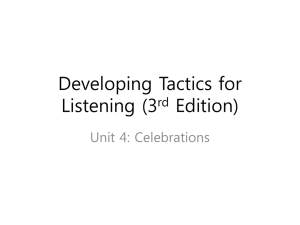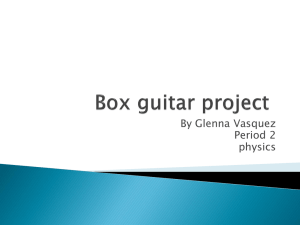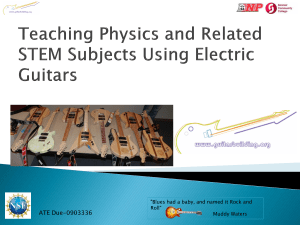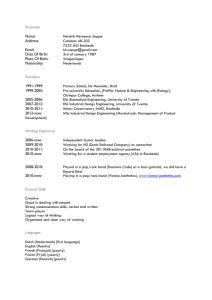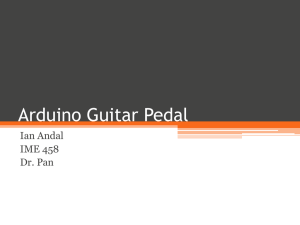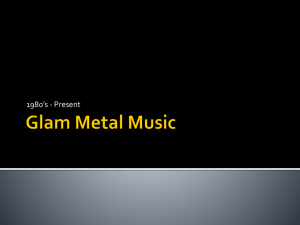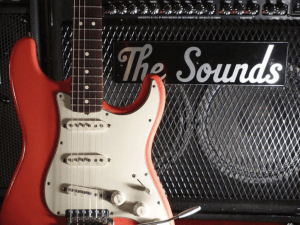Electric Counterpoint PowerPoint
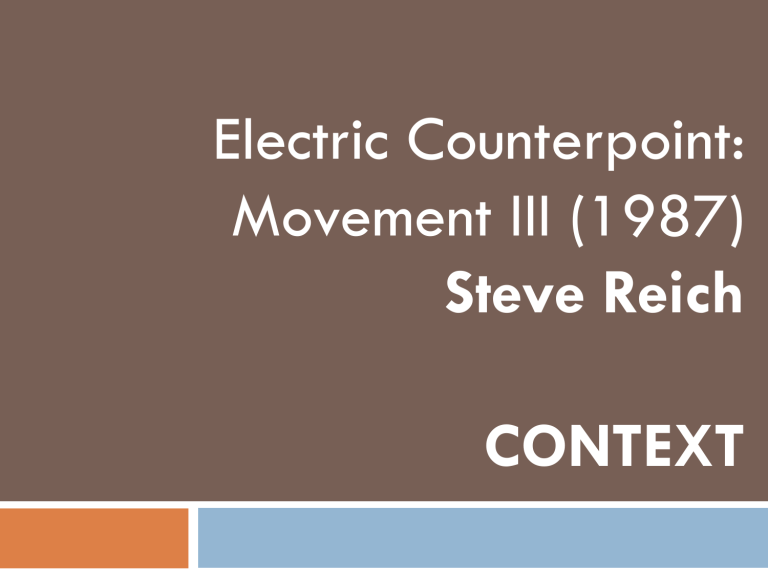
Electric Counterpoint:
Movement III (1987)
Steve Reich
CONTEXT
•
•
•
•
•
•
•
Throughout 20 th century composers tried to push music in new and exciting directions
Schoenberg pushed the boundaries of tonality by abandoning keys and developing the style we now know as expressionism.
Expressionism led into serialism
Serialism is a tightly controlled way of writing music – tone rows – very detailed
Every note would have a different dynamic and articulation marking
Some composers felt restricted and went in the opposite direction – sometimes the performers were like composers, as many of the scores used symbols which were open to interpretation.
Experimental scores: no detail; staff notation replaced by written direction (textbased); staff notation replaced by symbols and pictures (graphic scores)
MINIMALISM: CONTEXT
Minimalist composers La Monte Young and Terry Riley – fascinated with DRONES and
REPETITION
Young based entire pieces on one very long extended note, played loudly, with harmonics added
Much of Young’s music did not contain many different musical ideas and made use of minimal resources: led to ‘minimalism’.
Riley’s most important piece which brought minimalism to the forefront was “In C”, focuses on short musical fragments – Steve Reich played in the ensemble.
Minimalist music used in film soundtracks and tv programmes – influenced many rock and electronic pop music.
Minimalist music is always in constant state of change but the process is organic rather than dramatic.
MINIMALISM: CONTEXT
STEVE REICH
Electric Counterpoint III (3
rd
Movement)
STEVE REICH: SOUTH BANK
SHOW INTERVIEW PART 1
STEVE REICH: SOUTH BANK
SHOW INTERVIEW PART 2
•
Electric Counterpoint: last in a series of 3 pieces for soloists playing along with pre-recorded tracks
•
Other 2 pieces are: Vermont Counterpoint (1982) and New
York Counterpoint (1985)
•
Electric Counterpoint was commissioned for jazz guitarist Pat
Metheny to perform at Brooklyn Academy of Music’s “Next
Wave” festival
•
Metheny recorded all instrumental parts (12 guitar and 2 bass) under Reich and would be used as a stereo backing track – he would play the live part over this.
ELECTRIC COUNTERPOINT
•
Not just a backing track – an opportunity for the performer to perform in an ensemble with himself.
•
Must be very precise.
•
The piece is different to PHASING loops, but was composed/recorded to sound like a loop that develops. Multitracking the performer allows NOTE ADDITION and other development techniques to take place that otherwise would not be possible with a fixed loop.
•
The sounds are all coming from one source – the guitarist’s fingers and guitar.
ELECTRIC COUNTERPOINT
Electric Counterpoint:
Movement III (1987)
Steve Reich
PARTS & LAYERS
•
PARTS, LAYERS & KEY FEATURES
Like most minimalist music, Electric Counterpoint is built up in layers
•
•
It is entirely diatonic at the start
There are no chord progressions (STATIC HARMONY) and little variety in instrumentation for the first 24 bars
•
•
The movement is constructed in layers, starting with a MONOPHONIC texture that builds up to a four part canon (decorated by the live guitar)
Several of these layers feature NOTE ADDITION
ELECTRIC COUNTERPOINT
PARTS, LAYERS & KEY FEATURES
•
Movement 3 has 7 pre-recorded electric guitar parts and two bass guitars. The live guitar is performed along with the recorded parts (show video)
•
The piece is divided into two main sections and a coda:
SECTION A, SECTION B and CODA.
•
Each of the main sections is subdivided into four smaller sections, each of which is defined by a change in key and texture.
ELECTRIC COUNTERPOINT
PARTS, LAYERS & KEY FEATURES
The texture builds up gradually in section A with the guitar parts entering as follows:
GUITAR 1
LIVE GUITAR
GUITAR 2
GUITAR 3
GUITAR 4
BASS GUITARS 1 and 2
GUITAR 5
GUITAR 6
GUITAR 7
ELECTRIC COUNTERPOINT
•
•
•
•
•
PARTS, LAYERS & KEY FEATURES
The speed is 192 crotchets a minute (roughly three crotchets a second), which is a very fast tempo.
The time signature is 3/2, 3 minims per bar, which is a clear Triple Meter. However,
Reich splits each minim into 4 quavers so there are 12 quavers a bar, felt as 3 groups of 4 quavers. The quavers a beamed in groups of 4 even when there are rests.
Apart from dynamics and a pause sign on the last note, there are no other performing directions.
Reich lets his performer interpret how the music should be played (almost like
Baroque composers).
Guitar and bass notation is written an octave higher than it actually sounds, so the score actually sounds an octave lower than written.
ELECTRIC COUNTERPOINT
Electric Counterpoint:
Movement III (1987)
Steve Reich
SECTION A
•
•
SECTION A
•
Part 1 - Bars 1-23
The opening builds up in layers.
Notes are all in the high register (tessitura) of the guitar.
The piece begins with guitar 1 repeating a one bar syncopated ostinato
•
•
This ostinato is HEXATONIC – (G, A, B, D, E, F#) the missing pitch C does not appear until bar 24.
Live guitar starts with 3 notes of ostinato 1, building up to full ostinato by bar 6 using NOTE ADDITION.
•
Guitar 2 enters in bar 7 playing ostinato 1 but 1 crotchet later
ELECTRIC COUNTERPOINT
•
Guitar 3 enters in bar 10, building up to ostinato 1 using NOTE
ADDITION but in a different way to the live guitar. Guitar 3 ostinato displaced by 5 and a half crotchets.
•
•
Guitar 4 enters in bar 16 playing ostinato 1, displaced by 2 and a half crotchets.
Reich calls this a “four-part guitar canon” as guitar 4 doubles the live guitar part.
•
•
•
When all parts have entered (bar 17) the live guitar starts to play the
RESULTANT MELODY (pupils to spot doubled notes on score).
Each guitar part is playing the same ostinato but starting at different parts of the bar – this is known as METRICAL DISPLACEMENT.
The key is hinting at E minor, but this is not yet clear.
ELECTRIC COUNTERPOINT
•
•
•
•
•
Part 2 - Bars 24-35
Bass guitars enter, first playing in alternate bars and then continuously.
A two bar bass guitar ostinato is introduced gradually starting with the first bar and then adding notes until we hear the full 2 bar ostinato at bar 33.
E minor key becomes definite at bar 33.
One bass is panned to the left speaker, the other to the right speaker.
Live guitar continues to play the resultant melody.
ELECTRIC COUNTERPOINT
Part 3 - Bars 36-66
•
Strummed live guitar chords appear, with falling patterns that later become rising patterns.
•
This changes the texture dramatically as we now have a percussive sound that cuts across the other parts.
•
•
•
Guitar 5 chord sequence at bar 40: C, Bm, E5
Guitar 6 chord sequence at bar 52: C, D, Em
Guitar 7 chord sequence at bar 64: C, D, Bm
ELECTRIC COUNTERPOINT
Guitars 5 and 7 play at the same time but because the chords are played at different times in the bar, there is a new and interesting rhythmic counterpoint introduced.
Although the chords are heard on their own, they also overlap one some beats to create more complex chords.
The live guitar part continues to play chords in this section, interweaving with chord rhythms of guitars 5 and 7.
Part 4 - Bars 67-73
Strummed guitar counterpoint completed and live guitar part returns to playing melody – this is only obvious as they melody gets slightly louder.
ELECTRIC COUNTERPOINT
Electric Counterpoint:
Movement III (1987)
Steve Reich
SECTION B
C Major
D Major
Dorian Mode
T T ST T T T ST
T T
#
ST T
#
T T ST
T ST T T T ST T
Dorian Mode:
Starts on D (think D for Dorian) and uses all the WHITE notes like C Major.
However, because it starts on D instead of
C the order of the intervals is different to
C Major.
The order of the intervals in the Dorian
Mode is T-ST-T-T-T-ST-T
Electric Counterpoint:
Movement III (1987)

